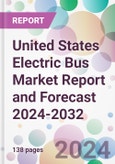Electric buses, characterised by their zero-emission operations, have become integral to the vision of a greener, more sustainable urban mobility landscape. These vehicles are at the forefront of transforming public transit networks, reducing dependency on fossil fuels, and contributing to the reduction of urban pollution levels.
As per the United States electric bus market analysis, federal and state-level policies and incentives play a crucial role in accelerating the adoption of electric buses across the United States. Initiatives such as grants, tax incentives, and funding for infrastructure development have lowered the barriers to entry for transit authorities and private operators. The Federal Transit Administration's Low or No Emission (Low-No) Grant Program, among others, exemplifies the governmental commitment to supporting transit agencies in acquiring electric buses and related charging infrastructure.
The United States electric bus market has benefited significantly from advancements in battery technology, electric drivetrains, and charging infrastructure. Improvements in battery energy density, charging speed, and overall vehicle efficiency have enhanced the range and performance of electric buses, making them increasingly competitive with traditional diesel counterparts. Moreover, the development of fast-charging and wireless charging solutions addresses one of the primary challenges of electric vehicle adoption which is range anxiety and long charging times.
Growing environmental awareness among the public and decision-makers has led to increased acceptance and demand for electric buses, fuelling the United States electric bus market growth. The visible impact of climate change and urban air quality concerns have spurred cities and transit agencies to adopt cleaner transportation solutions. Electric buses offer a tangible means of reducing carbon footprints, and noise pollution, and improving the overall quality of urban life.
While the initial purchase price of electric buses remains higher than that of conventional buses, the total cost of ownership over the vehicle's lifespan is lower due to reduced fuel and maintenance costs. This economic argument, coupled with the potential for long-term savings and environmental benefits, is compelling for many transit operators. As per the United States electric bus market outlook, the job creation potential in manufacturing, servicing, and infrastructure development for electric buses contributes to local economies and supports broader economic goals.
The adoption of electric buses in the United States varies significantly by region, with states like California, New York, and Washington leading in deployment and infrastructure development. These states have set ambitious targets for electrifying their public transit fleets, backed by substantial investments in charging infrastructure and pilot programs to test the viability of electric buses in different operational scenarios.
The United States electric bus market expansion is propelled by a mix of domestic and international manufacturers competing to provide innovative and reliable solutions. The competitive landscape is further enriched by partnerships between manufacturers, technology providers, and government agencies aimed at advancing electric bus technology and adoption.
The future of the market is promising, with continued growth anticipated in response to evolving regulatory policies, technological advancements, and shifting societal norms towards sustainability. The growing focus towards improving the efficiency of charging infrastructure, expanding the range of electric buses, and reducing costs through economies of scale and technological innovation is expected to boost the United States electric bus market share.
Market Segmentation
The market can be divided based on propulsion type, length, range, battery capacity, power output, and region.Market Breakup by Propulsion Type
- Fuel Cell Electric Vehicle (FCEV)
- Battery Electric Vehicle (BEV)
- Plug-in Hybrid Electric Vehicle (PHEV)
Market Breakup by Length
- Less Than 9 Meters
- 9-14 Meters
- Above 14 Meters
Market Breakup by Range
- Less Than 200 miles
- More Than 200 miles
Market Breakup by Battery Capacity
- Up to 400 kWh
- Above 400 kWh
Market Breakup by Power Output
- Up to 250kW
- Above 250kW
Market Breakup by Region
- New England
- Mideast
- Great Lakes
- Plains
- Southeast
- Southwest
- Rocky Mountain
- Far West
Competitive Landscape
The report looks into the market shares, plant turnarounds, capacities, investments, and mergers and acquisitions, among other major developments, of the leading companies operating in the United States electric bus market. Some of the major players explored in the report are as follows:- BYD Motors Inc.
- Volvo AB
- Daimler Truck Holding AG
- Hyundai Motor Company
- Proterra Inc.
- Gillig LLC
- Blue Bird Corporation
- Lion Electric Company
- NFI Group Inc.
- Motiv Power Systems Inc.
- GreenPower Motor Company Inc.
- Others
This product will be delivered within 5-7 business days.
Table of Contents
Companies Mentioned
- BYD Motors Inc.
- Volvo AB
- Daimler Truck Holding AG
- Hyundai Motor Company
- Proterra Inc.
- Gillig LLC
- Blue Bird Corporation
- Lion Electric Company
- NFI Group Inc.
- Motiv Power Systems Inc.
- GreenPower Motor Company Inc.
Methodology

LOADING...








